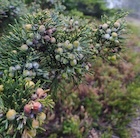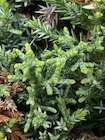Conservation Status

Juniperus chinensis var. sargentii
A. Henry (1912)
Common names
偃柏 yan bai (Fu et al. 1999); miyama-byakushin, shinpaku [Japanese] (Iwatsuki et al. 1995).
Taxonomic notes
Type: Japan, Hokkaido, Kitami Province, Rebun-jima; M. Furuse 9385, neotype K. POWO lists 8 synonyms, none in widespread use. Although Nakai (1930) elevated this variety to species rank, other authorities have consistently seen this as a naturally-occurring dwarf form of Juniperus chinensis.
Description
Dioecious evergreen shrub 0.5-2 m tall, usually procumbent, with dense crown, horizontal trunk and upright shoots. Leaves scale- or needle-like. Scale-like leaves predominant on adult plants, dark blue-green, rounded, diamond-shaped or oval, 3-6 mm long, with dark glands. Young needle-like leaves pointed, cylindrical, to 15 mm long. Seed cones fleshy, globose, 8-9 mm diameter, each with 2-3 triangular seeds. Pollination in July, seeds mature October-November of the next year (Harkevich and Kachura 1981, Iwatsuki et al. 1995, Fu et al. 1999).
Distribution and Ecology
Japan: S. Kuriles, Hokkaido, Honshu, Shikoku and Kyushu, in rocky places from near sea level to subalpine regions; China: Heilongjiang; rare in Russia: Sakhalin and South Kurile Islands; Korea; Taiwan (Harkevich and Kachura 1981, Iwatsuki et al. 1995, Fu et al. 1999).
This variety is rated "Least Concern" for conservation, due to "an extent of occurrence, area of occupancy and number of locations well beyond the threshold for a threatened category." There is also no evidence supporting an ongoing decline or significant threats (Farjon 2023).
Remarkable Specimens
No data as of 2025.01.03.
Ethnobotany
This dwarf form of J. chinensis has become an extremely popular ornamental, readily available from nurseries. I have not found any other uses reported.
Observations
No data as of 2025.01.03.
Remarks
The epithet honors Charles Sprague Sargent, who introduced this plant at the Arnold Arboretum (Boston, USA) in about 1892 and later brought it to the attention of A. Henry.
Citations
Farjon, Aljos. 2023. Juniperus chinensis var. sargentii. The IUCN Red List of Threatened Species 2023: e.T191578A83998042. https://dx.doi.org/10.2305/IUCN.UK.2023-1.RLTS.T191578A83998042.en., accessed on 2025.01.04.
Henry, A. 1912 in Elwes and Henry, Trees of Great Britain 6:1432. Available: Biodiversity Heritage Library, accessed 2025.01.03.
Nakai, Takenoshin. 1930. Notulae ad Plantas Japoniae & Koreae. Shokubutsugaku zasshi (Botanical Magazine Tokyo) 44:508. Available: doi.org/10.15281/jplantres1887.44.507.
See also
Adams, Robert P. 2014. Junipers of the World: The Genus Juniperus. Fourth edition. Trafford Publishing. P.110.
Farjon (2010), p. 396.





